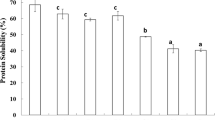Abstract
Effect of king oyster mushroom on the physicochemical and textural properties of cuttlefish surimi gel was investigated. Surimi gels containing 20, 30, 40, and 50%(w/w) king oyster mushroom were analyzed for color, rheological properties, and sensory attributes. Texture profile analysis of fish paste added with king oyster mushroom paste showed significant decrease on hardness, cohesiveness, and gumminess. Springiness of cuttlefish paste increased with the addition of king oyster mushroom paste. The results of the sensory evaluation showed that cuttlefish paste added with 30, 40, and 50% king oyster mushroom had higher overall acceptability compared with that of the control. However, flavor, softness, chewiness, and overall quality tended to decrease in 50% king oyster mushroom paste group. Therefore, this study suggests that king oyster mushroom paste and cuttlefish were suitable for surimi gel production and could be effective in improving the nutritional properties and functionality of surimi gel.
Similar content being viewed by others
References
KFDA. Food Code. Korea Food & Drug Administration, Seoul, Korea. pp. 239–242 (1998)
Park YK, Kim HJ, Kim MH. Quality characteristics of fried fish paste added with ethanol extract of onion. J. Korean Soc. Food Sci. Nutr. 33: 1049–1055 (2004)
Lee NG, You SG, Cho YJ. Optimum rheological mixed ratio of jumbo squid and Alaska pollack surimi for gel product process. Bull. Korean Fish Soc. 32: 718–724 (1999)
Yook HS, Lee JW, Lee HJ, Cha BS, Lee ST, Byun MW. Quality properties of fish paste prepared with refined dietary fiber from ascidian (Halocynthia roretzi) tunic. J. Korean Soc. Food Sci. Nutr. 29: 642–646 (2000)
Ha JU, Koo SG, Lee HY, Hwang YM, Lee SC. Physical properties of fish paste containing Agaricus bisporus. Korean J. Food Sci. Technol. 33: 451–454 (2001)
Koo SG, Ryu YK, Hwang YM, Ha JU, Lee SC. Quality properties of fish meat paste containing enoki mushroom (Flammulina velutipes). J. Korean Soc. Food Sci. Nutr. 30: 288–291 (2001)
Kim SY, Son MH, Ha JU, Lee SC. Preparation and characterization of fried surimi gel containing king oyster mushroom (Pleurotus eryngii). J. Korean Soc. Food Sci. Nutr. 32: 855–858 (2003)
Son MH, Kim SY, Ha JU, Lee SC. Texture properties of surimi gel containing shiitake mushroom (Lentinus edodes). J. Korean Soc. Food Sci. Nutr. 32: 859–863 (2003)
Yang MO, Cho EJ. Quality properties of surimi with added citrus fruits. J. East Asian Soc. Diet. Life 17: 58–63 (2007)
Park EJ, An SH, Park GS. Quality characteristics of cuttlefish inky tofu prepared with various coagulants. Korean J. Food Culture 21: 653–660 (2006)
Bae MS, Ha JU, Lee SC. Quality properties of high calcium fish paste containing anchovy. Korean J. Food Cook. Sci. 23: 561–566 (2007)
Shin YJ. Quality characteristics of fish paste containing lotus (Nelumbo nucifera) leaf powder. Korean J. Food Cook. Sci. 23: 947–953 (2007)
Huxtable RJ. Physiological actions of taurine. Physiol. Rev. 72: 101–163 (1992)
Mochizuki J, Oda H, Yokogoshi H. Increasing effect of dietary taurine on the serum HDL-cholesterol concentration in rats. Biosci. Biotech. Bioch. 62: 578–579 (1998)
Sakaguchi T. The metabolism, biological function, and nutritional availability of taurine. Health Digest 4: 1–9 (1989)
Outani K. An antitumor substance obtained from the internal shell of squid-isolation procedures and antitumor activity. Bull. Japan. Soc. Sci. Fish. 42: 449–453 (1976)
Park TS, Park JE, Chang JS, Son MW, Sohn KH. Taurine content in Korea foods of plant origin. J. Korean Soc. Food Sci. Nutr. 27: 801–807 (1998)
Park SM, Lee BB, Hwang YM, Lee SC. Quality properties of fish past containing styela clave. Korean J. Soc. Food Sci. Nutr. 35: 908–911 (2006)
Chang ST, Miles PG. Edible Mushrooms and Their Cultivation. CRC Press, Inc., London, UK. p. 335 (1989)
Pamela M, Stefania M, Altero A, Laura P. Commercial mushrooms: Nutritional quality and effect of cooking. Food Chem. 84: 201–206 (2004)
Shamtsyan M, Konusova V, Maksimova Y, Goloshchev A, Panchenko A, Simbirtsev A. Immunomodulating and anti-tumor action of extracts of several mushrooms. J. Biotechnol. 113: 77–83 (2004)
Sun J, He H, Xie BJ. Novel antioxidant peptides from fermented mushroom Ganoderma Lucidum. J. Agr. Food Chem. 52: 6646–6652 (2004)
Wasser SP, Weis AL. Medicinal properties of substances occurring in higher basidiomycetes mushrooms: Current perspectives (review). Int. J. Med. Mushrooms 1: 31–62 (1999)
AOAC. Official Methods of Analysis of AOAC Intl. 15th ed. Method 985.01. Association of Official Analytical Chemists, Washington, DC, USA (1990)
Park EK, Shin JW, Park KH, Yang ST. Seasonal variation in gel forming ability of wild common carp and conger eel. Korea J. Food Sci. Technol. 19: 1–4 (1987)
Ahn MS, Kim HJ, Seo MS. Physicochemical characteristics of ethanol extracts from each part of the Pleurotus eryngii. Korean J. Food Culture 21: 297–302 (2006)
Kim YY, Cho YJ. Relationship between quality of frozen surimi and jelly strength of kamaboko. Bull. Korean Fish Soc. 25: 73–78 (1992)
Author information
Authors and Affiliations
Corresponding author
Rights and permissions
About this article
Cite this article
Chung, S.I., Kim, S.Y., Nam, Y.J. et al. Development of surimi gel from king oyster mushroom and cuttlefish meat paste. Food Sci Biotechnol 19, 51–56 (2010). https://doi.org/10.1007/s10068-010-0007-0
Received:
Revised:
Accepted:
Published:
Issue Date:
DOI: https://doi.org/10.1007/s10068-010-0007-0




